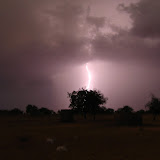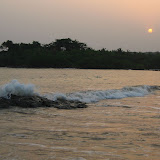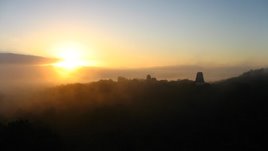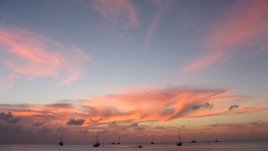Written 29 October
… which started at the border crossing. The Beninois border officials were ridiculous. Didn’t care for them. And before then, I was already feeling like we had been in that country for a little too long. Grand Popo wasn’t that cool. I mean, Busua Beach in Ghana was much better for the swimming, the seascape, and partying. But I was happy to get into Togo. And lucky for us, it was a short drive.
Coconut palms and papaya trees dominated the road along with the occasional pineapple grow. It was a nice ride along a beach that the great, late Ryszard Kapuscinski once called the longest fishing village in the world. He witnessed a coup in Benin back in the late 60s, if I remember correctly. We got into Benin and within 10 minutes witnessed a more capital development, more than anything I had seen in Burkina: heavy industry. A large campus devoted to cement manufacturing was positioned near the beach, a port very close by probably. If African countries are by the ocean, they have a much better time, I believe, as I witnessed with Togo and Benin vis-à-vis Burkina. If you have a coast, you have a medium by which to more easily take things on/move things to or from the exterior.
We got through that industrial park-by-the-sea and we were in Lomé, a bustling little city of less than a million right on a wide expanse of yellow, flat sand. The wide beach-side avenue was a crumbling disaster of a “road,” if you could call it that. There were hovels all along side it, the denizens living in an utterly bereft fashion. As the main beach road continued, there was a nice hotel tower and then the presidential palace. That’s Africa, hovels situated right next to the commercial eyesores and palatial estates. There were trash cans, something Burkina lacks in great numbers and many anti-HIV/AIDS advertisements, something good to see. It was a charming town, at least I thought. We took a stroll and had a street sandwich after dropping our gear in the Copacabana hotel. After the sandwich, we walked through the marché. Man, what a sight. It was crazy, a true frenzy of African market activity. Dried fish stalls right next to the pagne vendors, fake nikes and papayas and cabbages all rammed up close to one another. The buildings were tall, stacked up next to eachother, some in disrepair, others not completed, just spires of looped rebar jutting 10 feet into the sky. People hollering, cars honking, it was frenetic. It reminded me of the marché a little in Accra. I really liked it. All those pagnes, which are the bolts of cloth that you see Africans haggling so much. Lomé was cool.
After one night, we had to make a run for it. Our time was running out. We got a reasonable cab ride to Kpalimé (say paul-ee-may). It came highly recommended from Radhika, another PCV who recently COSed. Well, she was right. Even the ride was incredible. Mango, papayas, palms. Then, these trees that resembled Ceiba, the huge Mayan trees standing in Southern Mexico, Belize, Guatemala, and elsewhere in Central America. The mountains looming up. The thought of waterfalls, just the thought of water after being in the Sahel is magical. It was my favorite town of the trip. Wish I could’ve stayed for 4 nights instead of the two we had. Got street cheese that was great, the food was extra spicy (yea!), found Castle Milk Stouts the night before our departure. The people were nice, a lot of the Yovo thing going around (white person in Fon). David and I were stopped by some muslim brothers who didn’t want me taking a picture of their mosque… unless I gave them some baksheesh. I declined and we moved away, laughing with the Africans as we went. Mount Agou hung in the distance, a flat-topped peak in the distance, mingling with the gray-black swept sky in the foreground. Behind us the church loomed, the sky also looking uninviting.
The next day, we tripped to Kpimé Falls. After fighting with the “guides,” we finally got into the area for a decreased price. Thanks to Zach again for being willing to go at it with the guides. The trip was cool, up at first through tree cut zones to a higher plateau, where we came to a damned pool. Kpimé Falls itself was a damn with a valve-controlled culvert. Bust! I mean, it’s not even a vrai cascade, as I would say in French. The journey continued down a rich green trail, riddled with coffee bean, Ceiba trees, and the typical wicked black ants. Wild bananas and papaya trees everywhere. We came to a natural 50 foot cascade where we lingered, David and I trying to get pictures of the ridiculous butterflies while the others took a dip in the scummy looking pool. Then we hiked back out. Not nearly as cool as Wli Falls people, a vrai waterfall, the highest in West Africa, on the Togo frontier in Ghana. Go there instead.
We went back to Kpalimé and did a tour of some of the art places (good ones there) with a few purchases being made. We then got really good Togolais street food one last time. As we were sitting there eating admist the blasting music and general chaos of the candle lit street, we watched a little kid, about 4, pull up his one-ply thick cardboard pad, his improvised bed. He curled up on that and his mom lay on him a small blanket. That reminded me of Africa, the odd juxtaposition, the melange right there where it just doesn’t seem to work, but they make it work. Resilience, resourcefulness, that’s what Africa is.
We nearly got out of Togo the next day, making our way to Daopaong, a town 30 km from the Burkinabe border, after about 13 hours of transport. Yeah, it was kinda ugly. There were some good waterfalls gushing from the ridges along side the road. And I guess I got to share the back seat with my in-country wife, so that was fun! Togo, I wish I had more time for you.
Now, to the whole question: Are Peace Corps volunteers, when travelling in their region, ever really on vacation? I think, yes and no. First off, we bitch about prices unlike real tourists. We earn a pittance. Don’t get me wrong, it’s a generous sum that Africans would covet. But not enough to do the real tourist thing. We also know the whole dependency bit and see it too much. There is to some extent a reliance on volunteer work here. Look at the footprint of NGOs busting ass. When you see so much of it, it becomes tiring. That’s another factor. But then again, we are traveling and seeing different cultures, hearing different languages. Guess we just have to suck it up and deal with it. Plus, it’s cool that I get to do this. Travelling as a PCV with other PCVs is fun, especially when you meet PCVs from other countries, even in their site, like Grand Popo. We met the a girl, Elizabeth, who had just been sent their for only one week. What a place, what an experience. I am just blessed to be traveling francophone West Africa at all… but it’s super cool to trip on the US government’s dime!
Big Up from Aribinda
Friday, October 31, 2008
Subscribe to:
Post Comments (Atom)









1 comment:
Knowing what to expect with the culture, the food, and the transport are definitely advantages to traveling as a PCV instead of a tourist. Your bus ride to Benin would be really hard to deal with if you were used to complaining about not getting peanuts on airplanes. (By the way, they don't give you peanuts anymore AND they charge you for checked bags now. Can you believe it?! It's the worst traveling experience ever!)
However, knowing that you're getting the nasara price can really suck. 3500 F for riz sauce! That woman must be making a killing on dumb tourists!
Post a Comment